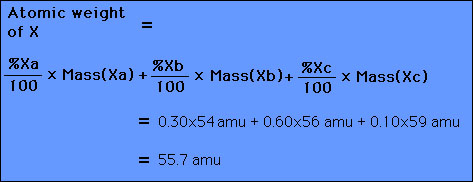Most elements can be found on earth (with the exception of those elements that too unstable and thus must be synthesized in the laboratory). Since all elements have isotopes then we must consider how much of one isotope of an element exists versus another isotope of the same element. These are called the "natural" abundances on earth. Natural Abundances:
Next, we can inquire what the mass of element X is? Since each isotope has a different mass (because each isotope has a different number of neutrons) the simplest answer is to give the "average" mass of element X - the atomic weight. After more analysis the mass of each isotope is determined to be the following:
Then the average mass (atomic weight) is given by:  The atomic weight of each element is included along with the element symbol in the periodic table. It is important to note that no one atom has a mass equal to that of the atomic weight. Remember: the atomic weight represents that average mass of the atoms. |
|||||||||||||||||||||||

